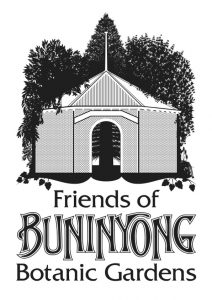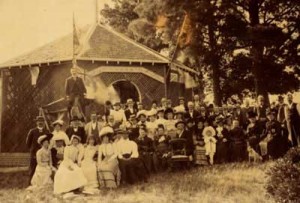A Brief History by Anne Beggs Sunter
The Buninyong Botanic Gardens are among the oldest in the State. In 1859 the first Buninyong Municipal Council reserved an area of 10 acres for the Botanical Gardens. The original plan of 1861 showed walks and bridges, fencing and gates and a proposal for bathing facilities. In 1872 Conrad Fegbeitel, a German immigrant, was appointed Curator for the Gardens and Superintendent of the Baths. The famous Ferdinand Von Mueller from the Melbourne Botanical Gardens, the curators of Ballarat and Geelong Gardens, the State Nursery at Creswick and local nurserymen all donated specimens of trees and plants. Following a devastating fire in 1876, the capacity of the Gong reservoir was greatly increased in order to ensure an adequate water supply in the event of another fire.
The Main Gardens consist of an Upper and Lower Section. The Upper Gardens centre around “The Gong”;, a small lake which is encompassed by a walking path. The ground to the North and East rises steeply to the Roman Catholic Church of St. Peter and Pauls. On these slopes there is a scattering of introduced European trees. This area has been recently developed with specimen trees of the Maple family (Acer species).
In 1990 the Old Sandstone Courthouse and its immediate surroundings were added to the Gardens Reserves. An area in the southwest has been excised to the Buninyong Bowling Club.
The gardens became a popular wayside stop for travellers and picnickers who came by train from Ballarat for a day’s outing to admire the ‘hilly picturesque countryside’ and the ornamental trees and flowering shrubs. The railway era was the heyday of the Buninyong Botanical Gardens. The service ended in 1937 and the track was dismantled in 1947.
Timeline
| 1850s | Present Gardens and Gong shown as a swampy area with a number of springs and tea tree. |
| 1850s | Cornish Street dam constructed. The original was small and centred of the northwest corner of the block, associated with the Brewery. |
| 1861 | Land reserved for Buninyong Public Gardens |
| 1864 | Borough Council spends one hundred pounds on fencing and improvements to Botanic Gardens. |
| 1866 | Dr Von Mueller, Director of Botanic Gardens, Melbourne supplies Buninyong with Garden plants, trees and seeds. |
| 1870s | Cornish Street dam enlarged to present Gong. Bluestone basin constructed to augment the reservoir (later adapted for Swimming Baths). Gardener’s cottage built (foundations remain on the site, now called Dawn’s Garden) |
| 1872 | Bowling Club established on the southwest corner of the Gardens. At that time, there was one green and the existing historic pavilion was added later. |
| 1890 | A tennis court was added, known as The Gentry’s Courts. |
| 1891 | Yuille Street, between Cornish and Inglis Streets, closed and added to the Gardens Reserve. Yuille Street trees planted. |
| 1901 | Queen Victoria Rotunda built to commemorate the reign of the late Queen, with seventy pounds raised by the ladies of Buninyong. Opened by Mayor Arthur Coxall. |
| 1900s | Kiosk and Shelter shed constructed to the northwest of the rotunda. The kiosk supplied light refreshments and hot water (remains of old copper) for Ballarat visitors who had travelled out on the “Bunny”. The Gardens caretaker’s family operated the kiosk and baths. |
| 1904 | Fernery built on northeast corner of the present Bowling Greens |
| 1915 | Borough and Shire amalgamate. “Ancient Villagers” believe this began the decline of the Gardens. |
| 1919 | Reinforced concrete wall and changing sheds erected around the old swimming baths – a Returned Soldiers project. |
| 1930s | Baths closed due to high E Coli count – however baths continued to be used according to Dutch migrants who arrived in the 1950s. |
| 1950s | Gardener’s cottage demolished and the timber used for Vince Scott’s garage (still standing on the southwest corner of Scott and Inglis Streets). Fernery also dismantled and Bowling Green expanded onto the vacated area. |
| 1962 | Bowling Club land excised from the Gardens |
| 2008 | 28th August an Araucaria columnaris, or Cook Pine, was planted. A native of New Caledonia, it replaced an older one in the Gardens. |




